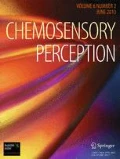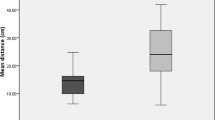Abstract
Introduction
Evidence for olfactory lateralization is mixed, although a left-sided benefit for odor identification seems likely. Whether lateralization of function is moderated by variables such as gender and handedness has been previously explored. However, there has been no test of whether psychopathy and empathy—personality characteristics which may themselves affect lateralization and which can affect olfactory function—moderate olfactory lateralization.
Methods
Eighty men and women engaged in mono-rhinal testing for odor threshold, identification, and discrimination ability, as well as completing standardized measures of psychopathy and empathy.
Results and Discussion
While there was a clear left-sided benefit for odor identification and discrimination, we found no evidence that psychopathy or empathy moderated these effects. When the current data were combined with that from previous studies, we found that psychopathy was correlated with poorer odor discrimination and identification, whereas empathy was correlated with enhanced discrimination and identification, pointing to processing commonalities between olfaction, psychopathy, and empathy.

Similar content being viewed by others
References
Bettison TM, Mahmut MK, Stevenson RJ (2013) The relationship between psychopathy and olfactory tasks sensitive to orbitofrontal cortex function in a non-criminal student sample. Chemosens Percept 6(4):198–210
Blair RJR (2006) Subcortical brain systems in psychopathy: the amygdala and associated structures. In: Patrick CJ (ed) Handbook of psychopathy. Guilford, New York, pp. 459–478
Blair KS, Newman C, Mitchell DGV, Richell RA, Leonard A, Morton J, Blair RJR (2006) Differentiating among prefrontal substrates in psychopathy: neuropsychological test findings. Neuropsychology 20(2):153–165
Brand G, Millot JL, Biju C (2000) Comparison between monorhinal and birhinal olfactory stimulations in bilateral electrodermal recordings. Life Sci 323:959–965
Broman DA, Olsson MJ, Nordin S (2001) Lateralization of olfactory cognitive functions: effects of rhinal side of stimulation. Chem Senses 26:1187–1192
Buchanan TW, Tranel D, Adolphs R (2003) A specific role for the human amygdala in olfactory memory. Learn Mem 10:319–325
Cochet H (2015) Manual asymmetries and hemispheric specialization: insight from developmental studies. Neuropsychologia. doi:10.1016/j.neuropsychologia.2015.12.019
Davis MH (1983) Measuring individual differences in empathy: evidence for a multidimensional approach. J Pers Soc Psychol 44:113–123
Doty RL, Kerr KL (2005) Episodic odor memory: influences of handedness, sex, and side of nose. Neuropsychologia 43:1749–1753
Gordon HW, Sperry RW (1969) Lateralization of olfactory perception in surgically separated hemispheres of man. Neuropsychologia 7(2):111–120
Hare RD (2003) The hare psychopathy checklist—revised, 2 edn. Multi–Health Systems, Toronto
Herz RS, McCall C, Cahill L (1999) Hemispheric lateralization in the processing of odor pleasantness versus odor names. Chem Senses 24(6):691–695
Hiatt KD, Newman JP (2006) Understanding psychopathy: the cognitive side. In: Patrick CJ (ed) Handbook of psychopathy. Guilford, New York, pp. 334–352
Homewood J, Stevenson RJ (2001) Differences in naming accuracy of odors presented to the left and right nostrils. Biol Psychol 58:65–73
Hudry J, Ryvlin P, Saivre A, Ravel N, Plailly J, Royet J (2014) Lateralization of olfactory processing: differential impact of right and left temporal lobe epilepsies. Epilepsy Behav 37:184–190
Hummel T, Sekinger B, Wolf SR, Pauli E, Kobal G (1997) ‘Sniffin’ sticks’: olfactory performance assessed by the combined testing of odor identification, odor discrimination and olfactory threshold. Chem Senses 22:39–52
Hummel T, Mohammadian P, Kobal G (1998) Handedness is a determining factor in lateralized olfactory discrimination. Chem Senses 23(5):541–544
Hummel T, Kobal G, Gudziol H, Mackay-Sim A (2007) Normative data for the Sniffin’ sticks including test of odor identification, odor discrimination, and olfactory thresholds: an upgrade based on a group of more than 3,000 subjects. Eur Arch Otorhinolaryngol 264:237–243
Jones-Gotman M, Zatorre RJ (1993) Odor recognition in human: role of the right temporal lobe and orbito-frontal regions. Brain Cogn 22:182–198
Knecht S, Dräger B, Deppe M, Bobe L, Lohmann H, Flöel A, Ringelstein EB, Henningsen H (2000) Handedness and hemispheric language dominance in healthy humans. Brain 123:2512–2518
Kobal G, Klimek L, Wolfensberger M, Gudziol H, Temmel A, Owen CM, Seeber H, Pauli E, Hummel T (2000) Multicenter investigation of 1,036 subjects using a standardized method for the assessment of olfactory function combining tests of odor identification, odor discrimination, and olfactory thresholds. Eur Arch Otorhinolaryngol 257:205–211
LaPierre D, Braun CMJ, Hodgins S (1995) Ventral frontal deficits in psychopathy: neuropsychological test findings. Neuropsychologia 33(2):139–151
Larsson M, Finkel D, Pederson NL (2000) Odor identification: influences of age, gender, cognition and personality. J Gerontol B-Psychol 55B(5):304–310
Mahmut MK, Stevenson RJ (2012) Olfactory abilities and psychopathy: higher psychopathy scores are associated with poorer odor discrimination and identification. Chemosens Percept 5:300–307
Mahmut MK, Homewood J, Stevenson RJ (2008) The characteristics of non–criminals with high psychopathy traits: are they similar to criminal psychopaths? J Res Pers 42:679–692
Mahmut MK, Menictas C, Stevenson RJ, Homewood J (2011) Validating the factor structure of the self-report psychopathy scale in a community sample. Psychol Assess 23(3):670–678
Mehrabian A, Epstein N (1972) A measure of emotional empathy. J Pers 40:525–543
Mitchell DGV, Colledge E, Leonard A, Blair RJR (2002) Risky decisions and response reversal: is there evidence of orbitofrontal cortex dysfunction in psychopathic individuals? Neuropsychologia 40(12):2013–2022
Paulhus DL, Neumann CS, Hare RD (2015) Manual for the self-report psychopathy scales, 4 edn. Multi-Health Systems, Toronto
Postolache TT, Doty RL, Wehr TA, Jimma LA, Han L, Turner EH, et al. (1999) Monorhinal odor identification and depression scores in patients with seasonal affective disorder. J Affect Disord 56:27–35
Roussy S, Toupin J (2000) Behavioral inhibition deficits in juvenile psychopaths. Aggress Behav 26:413–424
Royet JP, Plailly J (2004) Lateralization of olfactory processes. Chem Senses 29:731–745
Royet JP, Zald D, Versace R, Costes N, Lavenne F, Koenig O, Gervais R (2000) Emotional responses to pleasant and unpleasant olfactory, visual, and auditory stimuli: a positron emission tomography study. J Neurosci 20:7752–7759
Samter W, Burleson BR (1984) Cognitive and motivational influences on spontaneous comforting behavior. Hum Commun Res 11:231–260
Savic I, Gulyas B (2000) PET show that odors are processed both ipsilaterally and contralaterally to the stimulated nostril. Neuroreport 11:2861–2866
Savic I, Gulyas B, Larsson M, Roland P (2000) Olfactory functions are mediated by parallel and hierarchical processing. Neuron 26:736–745
Spinella M (2002) A relationship between smell identification and empathy. Int J Neurosci 112:605–612
Steiger JH (1980) Tests for comparing elements of a correlation matrix. Psychol Bull 38:245–251
Zald DH, Donndelinger MJ, Pardo JV (1998) Elucidating dynamic brain interactions with across-subjects correlational analyses of positron emission tomographic data: the functional connectivity of the amygdala and orbitofrontal cortex during olfactory tasks. J Cereb Blood Flow Metab 18(8):896–905
Author information
Authors and Affiliations
Corresponding author
Ethics declarations
Conflict of Interest
The authors declare that they have no conflicts of interest.
Ethical Approval
All procedures followed were in accordance with the ethical standards of the responsible committee on human experimentation (institutional and national) and with the Helsinki Declaration of 1975, as revised in 2008 (5).
Informed Consent
Informed consent was obtained from all patients for being included in the study.
Rights and permissions
About this article
Cite this article
Mahmut, M.K., Stevenson, R.J. Investigating Left- and Right-Nostril Olfactory Abilities with Respect to Psychopathy. Chem. Percept. 9, 131–140 (2016). https://doi.org/10.1007/s12078-016-9210-6
Received:
Accepted:
Published:
Issue Date:
DOI: https://doi.org/10.1007/s12078-016-9210-6



